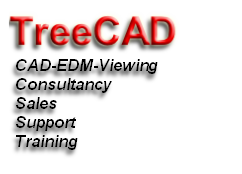File Storage
One of the key issues that all organizations face is the management and organization
of current on-line files. One of AutoEDMS' key strengths is its ability to catalog
and manage existing files in place, by existing filenames. This allows organizations
to quickly and easily implement the AutoEDMS document management system, at any and
all sites, without changing file storage locations, fileserver hardware, filenaming
conventions, etc. Some files and storage locations can remain "as is", while others
may need to be modified, based on a company's file management strategies. AutoEDMS
gives users the tools and migration paths needed to manage existing files and establish
good file storage methods for the future.
AutoEDMS will manage files on multiple servers, on local drives, on optical jukeboxes
and across Internet connections. It tracks files using its exclusive Dynamic Drive
Mapping (DDM) technology. DDM keeps track of files by their physical "UNC" location
(fileserver name/volume name/path and filename), instead of drive letters. This enables
each AutoEDMS database to locate the managed files, without being confused by user's
mismatched drive letters.
Import Routines Recognize Existing Storage Locations
Users can use a customized import routine in AutoEDMS to automatically fill-in database
field values, based upon codes used for directory names and filenames. This import
process helps users initially start with an intelligent document database that uses
existing directory and filenaming standards. The intelligent databases also help
users get up-to-speed quickly with their new document management system.
AutoEDMS also includes a Database Transfer tool. You can use it to quickly import
existing file data from spreadsheets, databases or other document management systems.
Intelligent Filenaming Provides Secure
Backup & Restore
Once the AutoEDMS document management system is on-line, it can automatically name
and store new files with intelligent filenames, based upon project names, part numbers,
job IDs, etc. These intelligent filenames are very important for backup and restore
procedures, in the event of hardware failure, etc. Since all AutoEDMS controlled
files are stored in standard network volumes, all standard backup and restore devices
and software can be used, either for full backup/restore or individual file backup/restore.
AutoEDMS can also provide the appropriate backup/restore "script" to the backup software.
Implementation Includes Customization
Off-the-shelf, AutoEDMS will probably meet about 80% of your needs. Every installation
has different requirements, and that "last 20%" is often the key to significant increases
in efficiency and productivity.
AutoEDMS includes a wide array of customization tools that give it the extra flexibility
and extensibility to stretch and fill that crucial last 20%. You can customize every
AutoEDMS database and Form with the graphical QwikForm program. Workflow routes are
designed with the Visual Workflow Designer. AutoEDMS also includes powerful Attaché
file management functions and the ACS Customization Language (ACL).
QwikForm Creates Custom Databases & Forms
The AutoEDMS QwikForm program is a Windows-based, graphical database and screen design
tool. Forms and databases are created with QwikForm, where database fields are "dragged
& dropped" on-screen. AutoEDMS Forms can be designed around colorful background images,
to customize AutoEDMS' entire look & feel. QwikForm includes a number of industry-specific
Form templates that you can use right out-of-the-box.
Attaché Functions Automate Document Management
AutoEDMS includes built-in Attaché document management functions, including revision
control, automatic filenaming, EMail links, mass database and file manipulation,
batch printing, and more. These powerful document management functions are easily
configured, without any programming. The Attaché functions can also be further customized
with the built-in ACL customization language.
Application Program Interface
AutoEDMS employs industry standards, including DDE, OLE, MAPI, ODMA, etc., though
an API called ACL (ACS Customization Language). The ACL language is a high-level
ASCII language, similar to batch commands or BASIC. The ACL language offers well
over 250 commands, including full user interface (list boxes, buttons, text input,
etc.), file input/output, string and math operators, conditional logic, client/server
DDE and more. The ACL language includes over 100 ACL program libraries and allows
system administrators to easily customize AutoEDMS to add functionality and fine-tune
the built-in Attaché functions. Custom search routines, drawing "sequencing" and
links to other databases and applications are good examples of the power of the ACL
language.
Since the ACL language is ASCII based and non-compiled, it is easy to implement required
changes. AutoEDMS does not require the use of low-level "APIs", so experienced programmers
are not needed to customize it. More importantly, as new versions of AutoEDMS become
available, existing ACL customization is saved, since only the main executable programs
are upgraded.
The flexible design of AutoEDMS allows each company to customize AutoEDMS to meet
their specific document management needs, now and in the future.













